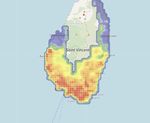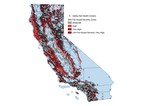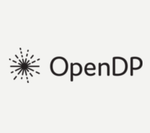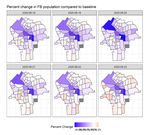Displacement and Gender on St Vincent Following the La Soufriere Volcanic Eruption
The La Soufriere volcano on the island of St Vincent began erupting on the 27th of December at the end of 2020. On April 13th, 2021 an enormous plume of ash and smoke spewed from the crater.
Where are Health Resources Most Needed to Prepare for the 2021 California Wildfire Season?
As California prepares for another wildfire season, safety net health facilities are preparing to meet the needs of populations that will be affected in coming months. Given the continued effects of the COVID-19 pandemic and ongoing resource limitations, those efforts need to be focused where impacts are likely to be greatest.
As Disaster Response Changes, Data Leads the Way
The environments in which disasters occur are changing. Populations are denser. Climates are more extreme. And technology is burgeoning into new realms. These changes have ushered in a new era of disaster response.
Vaccine Distribution, Deserts, and Data Analytics
Last week, President Joe Biden announced his goal of vaccinating 100 million Americans in his first 100 days in office. Equitably distributing a vaccine to that many Americans now stands as the country’s final and most daunting task to defeat the pandemic.
OpenDP: open-source software tools for privacy-protective statistical analysis of sensitive personal data.
The COVID-19 pandemic has underscored the importance of developing analytical pipelines that leverage data streams generated by individuals and communities to drive data-driven responses to crises. As these data increasingly exchange hands within agencies and are shared publicly for broader research, Salil Vadhan from Harvard SEAS and Navin Vembar from Camber Systems discuss the inadequacy of traditional methods for the protection of sensitive personal data.
National Shelter System Data: Opportunities, Challenges, and Applications to COVID-19
In the United States, the vast majority of shelters are operated by agencies like the American Red Cross, other not-for-profit organizations, or directly by the county government. During disasters, the sudden demand for services at these shelters contributes to challenges in resource allocation and complicates the logistics of keeping people safe during mass gatherings.
Mobility Data and the Limits of Data Protection Frameworks
The near real-time information about human movement provided by aggregated population mobility data has tremendous potential to help refine interventions when appropriate legal, organizational, and computational safeguards are in place. As the private sector, policymakers, and academia work together to leverage novel sources of data to track the spread of the pandemic, Randall Harp, Laurent Hébert-Dufresne, and Juniper Lovato from the University of Vermont argue that anonymization at the individual level is insufficient– the notion of privacy should extend to communities as well.
Government Access to Mobile Phone Data for Contact Tracing- The Brennan Center for Justice
The Brennan Center for Justice is a nonpartisan law and policy institute that conducts rigorous research to identify problems and provide in-depth empirical findings and compelling analyses of pressing legal and policy issues.
Digital Mobility Data, Physical Distancing, and COVID-19 in Syracuse
Syracuse is a modest sized city of just over 140,000 people in upstate New York. It sits within the heart of the Finger Lakes region, not far from Lake Ontario. Although far from the worst hit areas of New York state by COVID-19, Syracuse saw alarming increases in cases and deaths during the initial wave of the pandemic.
Many Displaced from Hurricane Laura Are Now in Path of Hurricane Delta
Hurricane Delta is set to make landfall as a Category 2 storm on the coast of Louisiana and western Mississippi on Friday, Oct. 9. This would be a serious situation under any circumstance, but for those still displaced from the last major storm in this area, Hurricane Laura, which made landfall on Aug.









